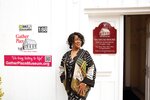
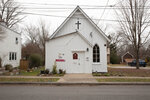

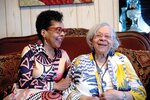

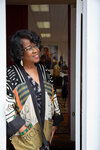


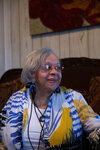

Shirley Lee Corsey’s house is the only African American-owned residence on South Canal Street in Yardley. If you stand at her front door and just glance to the left, you will see a modest white church with pointed arch windows.
Just a few years ago, the historic African Methodist Episcopal (A.M.E.) Church at 188 S. Canal St. was in disrepair.
“Varmints were coming through the back door,” recalls Corsey.
She decided to take matters into her own hands. Today, the church is proudly preserved by Corsey and several members of her family (self-named “The Dream Team”) since she became legal conservator of the property in 2022. The church and its affiliated 501(c)(3) are now named, “Gather Place” in memory of the historic African American community that gathered in the same building, dating back to the church’s founding in 1877.
Today, 1.3% of Lower Makefield/Yardley’s population is African American or Black. Corsey doesn’t know the percentage of African American community members that lived in Yardley when the A.M.E. Church first opened its doors. However, according to personal knowledge and some initial research, Corsey recalls the majority of homes on South Canal Street were owned by African American families as early as the 1940s. This is also the collective memory of other community members when referring to neighboring streets, such as Pennsylvania Avenue, South Bell Avenue and several other pocket streets in Yardley.
While notable Yardley families are often remembered as being the Yeardleys and the Cadwalladers, it was African American families whose parents, grandparents and great grandparents made their way from “The Boatyard” and “The Flats” neighborhoods towards uptown from sun up to sun down.
“I always say the African Americans…we were also the first families, but we were the ones who were the nannies [and] the cooks,” says Corsey.
Their names might not be etched in the street signs of Pennsylvania towns, but Corsey would argue these African American families are just as much founding families of Yardley borough as William Yeardley himself.
“We have a saying in the African American community: ‘Everywhere there’s us.’ …Not only ‘Everywhere there’s us,’ but…we’ve been here!”
Corsey’s mission is to learn, document and preserve the neighborhood’s rich African American history. She’s already made headway through restoration of the old A.M.E. Church building, and through educational programming run out of its lovingly preserved walls.
In January, Gather Place received a $75,000 grant from the National Trust for Historic Preservation to fund The Generational Voices Project.
Developed by Corsey and her team, it aims to preserve, through video interviews, the ancestral legacy and historical memory of the Yardley African American community as it is integral to the greater history of the borough and American history itself.
“My goal is to preserve these voices…so that they will become a permanent archive when we’re all gone,” says Corsey.
Once the project is completed, the videos will become available through an interactive library that people can reference.
Before receiving the grant, Corsey knew she needed to have a proof-of-concept. It wasn’t long before she found two families willing to share their stories.
Frank McIntyre Sr. remembers joining kids his age to play games in the open field at the end of South Canal Street.
“Though the field’s all fenced in [now], we had a tree with a peach basket on it. That was our basketball. We did everything out there. We played baseball, track…the whole shooting match.”
Like Corsey, McIntyre recounts a somewhat idyllic childhood in Yardley. His mother was a dedicated member of the A.M.E. Church community. On Sundays she would sit at the same pew near one of the pointed arch windows, and his father would know exactly where to pass her a note through the window telling her he was going fishing.
However, once McIntyre began attending Pennsbury High School, his perspective shifted. He began to realize that life as an African American outside of Yardley was starkly different.
This was 1957 when the Myers family, a young Black family, had moved into the predominantly white suburbs of Levittown.
Daisy and Bill Myers were the focus of national attention when they came under violent attack by local white residents hours after moving into their home among the uniformly groomed track houses of Levitt notoriety.
“The Levittown Incident” as it was documented in a 1957 New York Times article, exposed the racism of suburban America above the Mason-Dixon Line. It also exposed McIntyre and other African Americans in Yardley to what really lay outside their neighborhood streets.
As a high school student, McIntyre recalls looking at the newspaper and seeing a picture of the Myers’ front lawn in Levittown: “And there’s a picture of the [Myers’] front yard. Right? And there was a guy that I went to school with! Doing what all the rest of the people was doing…burning and throwing bricks and rocks and all that stuff. And there’s this guy. Big time picture in the paper with this guy that I’m graduating from high school with. And like I say, you don’t find out...Just being here. We’re different.”
McIntyre says being a bigger guy in high school, he was never worried for his own safety. However, his perspective did shift.
“I never felt no change as far as this area here (Yardley Borough) was concerned. You know, what those people was doing there was a new ballgame (though).”
Corsey’s Generational Voices Project has been a journey in documenting the oral histories of Yardley’s African American community, including the nuances and shifts of the area in relation to a greater American history over multiple generations. These shifts include a change in the borough’s racial diversity.
Residents like Susan Mayo-Brown and her family have seen a visible decline in African American families and homeowners over the decades. Mayo-Brown’s family has been a fixture in Yardley’s historic African American community. Her ancestors, the Derrys, are the oldest-known African American family in Yardley, dating back to 1790. Along with her parents, Helen Marie Vaughn Mayo (Marie) and Granville Mayo (Sonny), Mayo-Brown still lives in the house on Pennsylvania Avenue, built by her great grandmother’s family.
The Mayos both in their nineties, are grade school sweethearts. Granville “Sonny” Mayo still has distinct memories of September 1952, leaving the bubble-like atmosphere of Yardley, and getting on a bus in Philadelphia with 30 other army recruits to Parris Island, S.C. from where he would later disembark to serve in Korea.
At a rest stop in nearby Buford, S.C., Mayo remembers walking off the bus and being directed with three other African American men to one entrance of the restaurant, while his fellow white recruits were directed toward the dining room. He found himself at a table set up in the kitchen.
“We found out where we was going to have breakfast. It was in the kitchen where they cooked. But now…” a small smirk appears and he chuckles, saying, “They had a table well, set and everything. Everything. We just couldn’t eat in the dining room.” His daughter Susan Mayo-Brown chimes in, “And the food was hotter! It was fresh, right? Fresh off the stove!”
As a child growing up on Pennsylvania Avenue, Mayo-Brown recalls the entire row of 15 homes on her family’s side of the street being mostly owned and lived in by African American families, with other houses owned by white families dappled throughout the block.
However, as the years went on, the original owners grew older and passed away, and many families decided to sell their properties. Most homes ended up being bought by non-African American families.
“The family homes that are within this three-block radius that still have African American families in them are members of those same families of when I was a little girl,” says Mayo-Brown.
In addition to homes being increasingly bought up by non-African American families, she has seen another trend in town.
“Main Street has been built up with eating places and entertainment. And outside of the burrito place, none of them…none of the business owners are people of color,” she said. “All up and down that strip. It would be nice to have a Black-owned business on Main Street. My children and I talk about it all the time.”
Then Mayo-Brown explains that the expense of it is too much.
“And, you have to think, will it survive in this area?” she wondered. “Because there are only a handful of us [people of color] right here in the area, you know. So you have to think of all that.”
Corsey feels this impending loss, and with it a sense of urgency to preserve the historical memory of the African American community in Yardley.
“My goal is to preserve these voices…so that they will become a permanent archive…when we’re all gone,” she said.
The title, “Generational Voices,” comes from one of Corsey’s favorite sermons about “generational blessings.”
“A generational blessing means when you receive it in your lifetime on Earth, you’re supposed to do something with it,” she explained. “You’re supposed to improve it, expand it.”
For Corsey, the Generational Voices Project is the next phase in expanding the blessing she’s received in her journey of becoming conservator of the historic A.M.E. church.
Doug Miller, the site director at Pennsbury Manor and a valued supporter of Corsey’s work, showed up one day to the church while it was still mid-restoration.
“The place was still dusty,” recalled Corsey.
Miller offered her some simple advice that she still holds dear to this day: “Shirley, protect the envelope.”
This was Miller’s way of telling Corsey to start with the outside of the building, and work inwards. Two years later, she’s done much more than just protect the facade of this 19th century structure. Corsey has tasked herself with protecting the envelope that is the generational wisdom of the community. It’s as if through her studiously researched reenactments of Harriet Tubman, Corsey has inherited a part of the female abolitionist’s courage and drive in her mission to preserve the dignity of her community.
“If I can just be a little part of that spirit (of Harriet Tubman), I will receive it,” she said. “She couldn’t read or write, was considered not an attractive woman, was tiny, and look what she did. One thing is consistent: she said it was by divine intervention.”
But gentrification is not always “black and white”; as the African American community has begun to age or move out, there is a concerted effort to support Corsey in her mission, both from within the African American community and beyond it.
Susan Taylor, president of the Board of Directors at the Yardley Historical Association has been a key supporter of Corsey’s and her work in the community. In her bid to become conservator of the church property, Corsey says she received a “wonderful letter of support” from Taylor.
And in November 2020, community member Gabrielle Cancelliere showed up at the A.M.E. Church building as a curious student of historic preservation at Bucks County Community College (BCCC).
“(Shirley) saw me walking around the building taking pictures,” Cancelliere said. “She comes down and asks, ‘Who are you?’ and I said, ‘I’m nobody. I’m just a student and I’m interested in this building.’ More neighbors came out and we just kept talking.”
As the sun was setting and more people came outside, Cancelliere saw textbook lessons come to life right in front of her.
“It was a very vivid thing you remember in your brain,” she said. “They started talking about the building, the comings and goings of people, who’s watching over it, and how we can preserve it… I realized this is something they teach us in preservation classes — this is how it happens. Grassroots organizations and people.”
Cancelliere and Corsey exchanged information that day. In the meantime, Cancelliere would continue to share any research she could find at the Bucks County research library with Corsey. However, as time passed, Cancelliere temporarily lost touch with Corsey.
After graduating with a certificate in historic preservation, Cancelliere eventually found her way back to the recently renamed Gather Place and its magnetic conservator.
“I saw a yard sign advertising an open house at the AME Church with [Corsey’s] name on it,” she recalled. “And I was like, ‘No way! She’s doing it!’.”
Cancelliere went to Corsey’s next event and they reconnected.
“She was like, ‘Get in here girl. We have work to do.’ That’s how I got here,” she said.
Cancelliere now volunteers as Gather Place’s museum educator, researcher and administrative assistant.
“Shirley calls me her ‘right-hand jack of all trades’,” she says proudly.
Corsey credits Cancelliere for discovering the Preserving Black Churches program that led to the Generational Voices Project receiving the funds needed to continue.
Cancelliere admits that she grew up in Bucks County with a set of preconceived notions about the area being a settlement of mostly white people for so long; learning about the African American community and forming a close relationship with Corsey and the AME Church has given her purpose in her newfound vocation. She sees her role as a preservationist, as well as an activist.
“In historic preservation, there’s this trend of wanting to enhance our understanding of American history and the places we live,” she said. “In preserving them, increasing our understanding of our own history helps us create a more equitable future for everyone.”
And for Corsey, a more equitable future includes a dignified and inclusive recorded history.
“It’s all history,” Shirley emphasizes.
And she is determined to preserve the legacy of the African American community in Yardley for generations to come, regardless of what the future may hold.
Join our readers whose generous donations are making it possible for you to read our news coverage. Help keep local journalism alive and our community strong. Donate today.